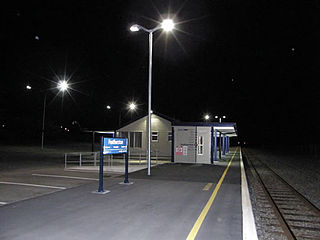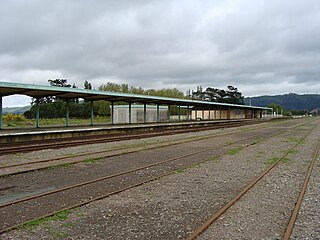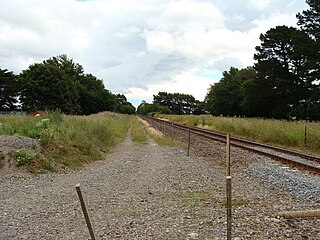
The Rimutaka Incline was a 3-mile-long (4.8 km), 3 ft 6 in gauge railway line on an average grade of 1-in-15 using the Fell system between Summit and Cross Creek stations on the Wairarapa side of the original Wairarapa Line in the Wairarapa district of New Zealand. The term "Rimutaka Incline" is sometimes used incorrectly to refer to other parts or all of the closed and deviated section of the Wairarapa Line between Upper Hutt and Speedy's Crossing, near Featherston. The incline formation is now part of the Remutaka Rail Trail.

The Wairarapa Line is a secondary railway line in the south-east of the North Island of New Zealand. The line runs for 172 kilometres (107 mi), connects the capital city Wellington with the Palmerston North - Gisborne Line at Woodville, via Lower Hutt, Upper Hutt and Masterton.
The Wairarapa Mail was a passenger train operated by the New Zealand Railways Department (NZR) between Wellington and Woodville, continuing on to Palmerston North as a mixed train. It ran from 1909 until 1948 and its route included the famous and arduous Rimutaka Incline.

Carterton railway station is a suburban railway station serving Carterton, New Zealand. The station is located on the Wairarapa Line, 76.6 km (47.6 mi) north of Wellington and 14.4 km (8.9 mi) south of Masterton. The Wairarapa Connection serves the station several times daily with services to Wellington and Masterton. The station has a single seven-car side platform.

Masterton railway station is a single-platform, urban railway station serving the town of Masterton in New Zealand's Wairarapa district. Located at the end of Perry Street, it is one of three stations in Masterton, the others being Renall Street and Solway. Masterton station is the terminus for Wairarapa Connection passenger services on Metlink's Wairarapa Line from and to Wellington. The average journey time to Wellington is one hour and forty-three minutes.

Woodside railway station is a rural railway station located in the Wairarapa, 5 km west of and serving Greytown, New Zealand. The station is located on the Wairarapa Line, 65.1 km (40.5 mi) north of Wellington and 25.9 km (16.1 mi) south of Masterton. The Wairarapa Connection serves the station several times daily with services to Wellington and Masterton.

Featherston railway station is a single-platform, urban railway station serving the town of Featherston in the Wairarapa district of New Zealand. The station lies on the Wairarapa Line, and is located between Harrison Street West and Harrison Street East. It is thirty-five minutes journey time to Masterton, or fifty five minutes journey time to Wellington.

Renall Street railway station is an urban single-platform railway station on Renall Street in the Wairarapa town of Masterton in New Zealand’s North Island. Renall Street is one of three railway stations in Masterton, the others being Masterton and Solway.

Upper Hutt railway station is a suburban railway station serving central Upper Hutt, New Zealand. The station is on the Wairarapa Line, 32.4 km (20.1 mi) north of Wellington, and is served by Transdev Wellington on behalf of the Greater Wellington Regional Council. The station is the northern terminus for the electrified Hutt Valley Line to and from Wellington. The diesel-hauled Wairarapa Connection stops at Upper Hutt on its route between Wellington and Masterton.

Waingawa railway station is a station on the Wairarapa Line in the Masterton district of New Zealand's North Island. It is located about 1 kilometre (0.62 mi) south of the Waingawa River and is situated in a heavy industrial area. It served passenger trains until 1992 and now only handles freight.

Woodville railway station is the northern terminus of the Wairarapa Line and is located at the junction with the Palmerston North–Gisborne Line in the small Tararua town of Woodville, 27 km (17 mi) east of Palmerston North in New Zealand's North Island.

Newman railway station was a station on the Wairarapa Line in the Tararua District area of the Manawatū-Whanganui region of New Zealand’s North Island. It served the small rural community of Newman, 3 kilometres (1.9 mi) north of Eketāhuna. It is accessed via Cliff Road, but is now located on private property.

Pahiatua railway station is on the Wairarapa Line in New Zealand's North Island. It was opened in May 1897, shortly before the line was opened to Woodville in December of that year. The station is located in Mangamutu, 1.7 kilometres (1.1 mi) west of Pahiatua, in contrast to the original plans for the railway line to run through the town.

Fernside railway station was a flag station that served the small rural community of Fernside, north-east of Featherston in New Zealand’s North Island. It was located on the Wairarapa Line near the southern bank of the Tauherenikau River. The station opened to traffic in 1880 and closed nearly a century later in 1975.

Dalefield railway station was a station on the Wairarapa Line that served the small rural community of Dalefield, just south of Carterton in the Wairarapa region of New Zealand’s North Island. It survived for just over a century from when the line opened in 1880 until it was closed in 1981.

Clareville railway station was a flag station serving the small settlement of Clareville, north of Carterton in the Wairarapa region of New Zealand's North Island. It survived for nine decades from when it opened in 1880 until closure to all traffic in 1970.

Mangamahoe railway station served the small rural community of Mangamahoe in the Wairarapa region of New Zealand’s North Island. It was located on the Wairarapa Line between the stations of Mauriceville and Eketahuna with vehicular access from Station Road. It is the northernmost station site on the Wairarapa Line within the jurisdiction of the Greater Wellington Regional Council before the line passes into territory governed by Horizons Regional Council.

Mauriceville railway station was a rural railway station that served the small village of Mauriceville in the Wairarapa region of New Zealand’s North Island. It was located on the Wairarapa Line between the stations of Kopuaranga and Mangamahoe with direct vehicular access from Opaki Kaiparoro Road.

Opaki railway station served the small rural village of Opaki, 6 km (3.7 mi) north of Masterton, in the Wairarapa region of New Zealand’s North Island. It was located on the Wairarapa Line between the stations of Masterton and Kopuaranga with vehicular access from Wingate Road.

Kopuaranga railway station was a flag station that served the small rural settlement of Kōpuaranga, 12½ km north of Masterton, in the Wairarapa region of New Zealand’s North Island. It was located on the Wairarapa Line between the stations of Opaki and Mauriceville. From its opening in 1886 it handled both passenger and freight traffic for 97 years until closure in 1983.


















